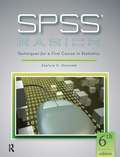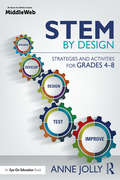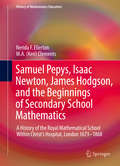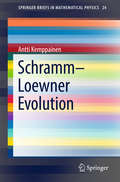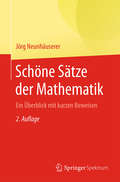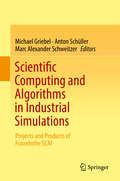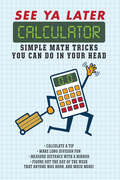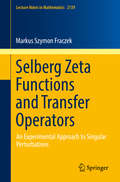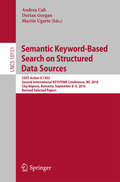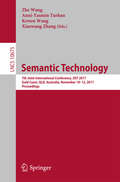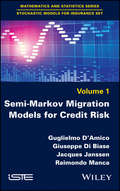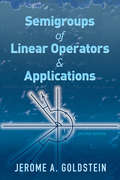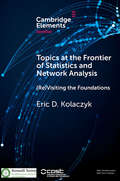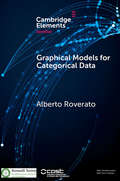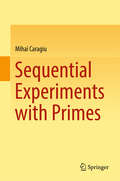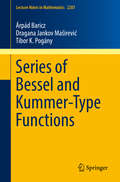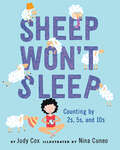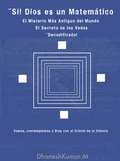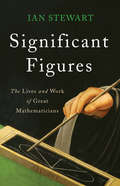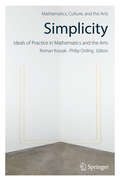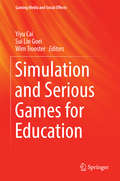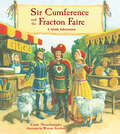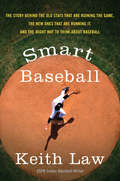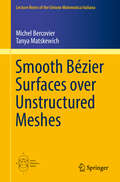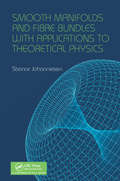- Table View
- List View
SPSS Basics: Techniques for a First Course in Statistics
by Zealure C. HolcombThis text takes the guesswork out of using SPSS, with screenshots that show each step for calculating each statistic. It includes extensive coverage of how to format raw SPSS output for inclusion in research reports. End-of-chapter exercises help students master their newly acquired skills. An instructor's answer key will be included with each complimentary examination copy. New to this edition: This edition includes an abundance of instructional screenshots, all of which have been updated to reflect the new look of IBM SPSS Statistics Version 23. Instructor ancillaries that accompany this text include PowerPoints for classroom instruction, and test banks in text format and importable to Respondus.
STEM by Design: Strategies and Activities for Grades 4-8
by Anne JollyHow do you create effective STEM classrooms that energize students, help them grow into creative thinkers and collaborators, and prepare them for their futures? This practical book from expert Anne Jolly has all the answers and tools you need to get started or enhance your current program. Based on the author’s popular MiddleWeb blog of the same name, STEM by Design reveals the secrets to successful lessons in which students use science, math, and technology to solve real-world engineering design problems. You’ll learn how to: Select and adapt quality existing STEM lessons that present authentic problems, allow for creative approaches, and engage students in meaningful teamwork; Create your own student-centered STEM lessons based on the Engineering Design Process; Assess students’ understanding of basic STEM concepts, their problem-solving abilities, and their level of engagement with the material; Teach STEM in after-school programs to further build on concepts covered in class; Empower girls to aspire to careers in STEM and break down the barriers of gender bias; Tap into STEM's project-based learning style to attract and engage all students. Throughout this user-friendly book, you’ll find design tools such as checklists, activities, and assessments to aid you in developing or adapting STEM lessons. These tools, as well as additional teacher resources, are also available as free downloads from the book’s website, http://www.stem-by-design.com.
Samuel Pepys, Isaac Newton, James Hodgson, and the Beginnings of Secondary School Mathematics
by M. A. Ken Clements Nerida F. EllertonThis book tells one of the greatest stories in the history of school mathematics. Two of the names in the title--Samuel Pepys and Isaac Newton--need no introduction, and this book draws attention to their special contribution to the history of school mathematics. According to Ellerton and Clements, during the last quarter of the seventeenth century Pepys and Newton were key players in defining what school mathematics beyond arithmetic and elementary geometry might look like. The scene at which most of the action occurred was Christ's Hospital, which was a school, ostensibly for the poor, in central London. The Royal Mathematical School (RMS) was established at Christ's Hospital in 1673. It was the less well-known James Hodgson, a fine mathematician and RMS master between 1709 and 1755, who demonstrated that topics such as logarithms, plane and spherical trigonometry, and the application of these to navigation, might systematically and successfully be taught to 12- to 16-year old school children. From a wider history-of-school-education perspective, this book tells how the world's first secondary-school mathematics program was created and how, slowly but surely, what was being achieved at RMS began to influence school mathematics in other parts of Great Britain, Europe, and America. The book has been written from the perspective of the history of school mathematics. Ellerton and Clements's analyses of pertinent literature and of archival data, and their interpretations of those analyses, have led them to conclude that RMS was the first major school in the world to teach mathematics-beyond-arithmetic, on a systematic basis, to students aged between 12 and 16. Throughout the book, Ellerton and Clements examine issues through the lens of a lag-time theoretical perspective. From a historiographical perspective, this book emphasizes how the history of RMS can be portrayed in very different ways, depending on the vantage point from which the history is written. The authors write from the vantage point of international developments in school mathematics education and, therefore, their history of RMS differs from all other histories of RMS, most of which were written from the perspective of the history of Christ's Hospital.
Schramm–Loewner Evolution
by Antti KemppainenThis book is a short, but complete, introduction to the Loewner equation and the SLEs, which are a family of random fractal curves, as well as the relevant background in probability and complex analysis. The connection to statistical physics is also developed in the text in an example case. The book is based on a course (with the same title) lectured by the author. First three chapters are devoted to the background material, but at the same time, give the reader a good understanding on the overview on the subject and on some aspects of conformal invariance. The chapter on the Loewner equation develops in detail the connection of growing hulls and the differential equation satisfied by families of conformal maps. The Schramm-Loewner evolutions are defined and their basic properties are studied in the following chapter, and the regularity properties of random curves as well as scaling limits of discrete random curves are investigated in the final chapter. The book is aimed at graduate students or researchers who want to learn the subject fairly quickly.
Schöne Sätze der Mathematik
by Jörg NeunhäusererIn diesem Buch finden Sie Perlen der Mathematik aus 2500 Jahren, beginnend mit Pythagoras und Euklid über Euler und Gauß bis hin zu Poincaré und Erdös. Sie erhalten einen Überblick über schöne und zentrale mathematische Sätze aus neun unterschiedlichen Gebieten und einen Einblick in große elementare Vermutungen.Die Vielfalt an schönen Resultaten bietet eine einzigartige mathematisch-allgemeinbildende Lektüre auf akademischem Niveau.Die Beweise in diesem Buch sind möglichst einfach und kurz gehalten und vermitteln Ihnen wesentliche Ansätze, Ideen und Strategien ohne große Vorkenntnisse vorauszusetzen. Die verwendeten Begriffe werden zumeist im Text eingeführt und zu grundlegenden Begriffen steht Ihnen zusätzlich ein Anhang zur Verfügung.Als Student der Mathematik oder Naturwissenschaften können Sie das Buch verwenden, um Ihre Perspektive zu erweitern und Ihre mathematische Bildung zu vertiefen. Hochschullehrer können jedes Kapitel des Buches zur Ausgestaltung eines Proseminars heranziehen. Wenn Sie einfach nur an Mathematik interessiert sind, und die Analysis und Lineare Algebra ein wenig kennen, wird Sie dieses Buch in das Reich der reinen Mathematik entführen.Die vorliegende zweite Auflage ist vollständig durchgesehen und um etliche Themen wie zum Beispiel den Satz von Hall und Kettenbrüche ergänzt.
Scientific Computing and Algorithms in Industrial Simulations
by Michael Griebel Marc Alexander Schweitzer Anton SchüllerThe contributions gathered here provide an overview of current research projects and selected software products of the Fraunhofer Institute for Algorithms and Scientific Computing SCAI. They show the wide range of challenges that scientific computing currently faces, the solutions it offers, and its important role in developing applications for industry. Given the exciting field of applied collaborative research and development it discusses, the book will appeal to scientists, practitioners, and students alike. The Fraunhofer Institute for Algorithms and Scientific Computing SCAI combines excellent research and application-oriented development to provide added value for our partners. SCAI develops numerical techniques, parallel algorithms and specialized software tools to support and optimize industrial simulations. Moreover, it implements custom software solutions for production and logistics, and offers calculations on high-performance computers. Its services and products are based on state-of-the-art methods from applied mathematics and information technology.
See Ya Later Calculator: Simple Math Tricks You Can Do in Your Head
by Editors of Portable PressThe math book for anyone who thinks they hate math, full of easy, entertaining and practical tricks for mentally solving problems in seconds.No matter how much you might try to avoid numbers, we all use math every day to calculate a tip, figure out an interest rate, or estimate the cost of the groceries in your cart. But the good news is, math can be easy—and even fun—if you know how to do it all in your head.With these simple and downright magical math tricks, you can do everyday math faster than it takes to dig out your phone and find the calculator app. Step-by-step and easy-to-memorize directions show more than 125 math operations anyone can do in their head.Plus, it features do-it-yourself math projects, puzzles, and a bonus section for advanced mathophiles. Get ready to tackle problems such as . . .• How to easily square any number • How to add three-digit numbers • How to use a mirror to measure the height of a building • How to make a ruler out of a dollar bill • How to use geometry to paint walls, cut floor tiling, and do other home renovations • How to subtract numbers . . . by adding And lots more . . . No calculator required.
Selberg Zeta Functions and Transfer Operators
by Markus Szymon FraczekThis book presents a method for evaluating Selberg zeta functions via transfer operators for the full modular group and its congruence subgroups with characters. Studying zeros of Selberg zeta functions for character deformations allows us to access the discrete spectra and resonances of hyperbolic Laplacians under both singular and non-singular perturbations. Areas in which the theory has not yet been sufficiently developed, such as the spectral theory of transfer operators or the singular perturbation theory of hyperbolic Laplacians, will profit from the numerical experiments discussed in this book. Detailed descriptions of numerical approaches to the spectra and eigenfunctions of transfer operators and to computations of Selberg zeta functions will be of value to researchers active in analysis, while those researchers focusing more on numerical aspects will benefit from discussions of the analytic theory, in particular those concerning the transfer operator method and the spectral theory of hyperbolic spaces.
Semantic Keyword-Based Search on Structured Data Sources: COST Action IC1302 Second International KEYSTONE Conference, IKC 2016, Cluj-Napoca, Romania, September 8–9, 2016, Revised Selected Papers (Lecture Notes in Computer Science #10151)
by Andrea Calì Dorian Gorgan Martín UgarteThis book constitutes the thoroughly refereed post-conference proceedings of the Second COST Action IC1302 International KEYSTONE Conference on Semantic Keyword-Based Search on Structured Data Sources, IKC 2016, held in Cluj-Napoca, Romania, in September 2016. The 15 revised full papers and 2 invited papers are reviewed and selected from 18 initial submissions and cover the areas of keyword extraction, natural language searches, graph databases, information retrieval techniques for keyword search and document retrieval.
Semantic Technology: 7th Joint International Conference, JIST 2017, Gold Coast, QLD, Australia, November 10-12, 2017, Proceedings (Lecture Notes in Computer Science #10675)
by Zhe Wang Anni-Yasmin Turhan Kewen Wang Xiaowang ZhangThis book constitutes the thoroughly refereed proceedings of the 7th Joint International Semantic Technology Conference, JIST 2017, held in Goldcoast, QLD, Australia, in November 2017. The 19 full papers and 4 short papers presented were carefully reviewed and selected from 37 submissions. They present applications of semantic technologies, theoretical results, new algorithms and tools to facilitate the adoption of semantic technologies and are organized in topical sections on ontology and data management; ontology reasoning; linked data and query; information retrieval and knowledge discovery; knowledge graphs; and applications of semantic technologies.
Semi-Markov Migration Models for Credit Risk
by Jacques Janssen Raimondo Manca Giuseppe Di Biase Guglielmo D'AmicoCredit risk is one of the most important contemporary problems for banks and insurance companies. Indeed, for banks, more than forty percent of the equities are necessary to cover this risk. Though this problem is studied by large rating agencies with substantial economic, social and financial tools, building stochastic models is nevertheless necessary to complete this descriptive orientation.This book presents a complete presentation of such a category of models using homogeneous and non-homogeneous semi-Markov processes developed by the authors in several recent papers. This approach provides a good method of evaluating the default risk and the classical VaR indicators used for Solvency II and Basel III governance rules.This book is the first to present a complete semi-Markov treatment of credit risk while also insisting on the practical use of the models presented here, including numerical aspects, so that this book is not only useful for scientific research but also to managers working in this field for banks, insurance companies, pension funds and other financial institutions.
Semigroups of Linear Operators and Applications: Second Edition (Dover Books on Mathematics)
by Jerome A. GoldsteinThis advanced monograph of semigroup theory explores semigroups of linear operators and linear Cauchy problems. Suitable for graduate students in mathematics as well as professionals in science and engineering, the treatment begins with an introductory survey of the theory and applications of semigroups of operators. Two main sections follow, one dedicated to semigroups of linear operators, and the other to linear Cauchy problems. Author Jerome A. Goldstein emphasizes motivation and heuristics as well as applications. Each of the two sections concludes with further applications and historical notes. Challenging exercises appear throughout the text, which includes a substantial bibliography. This edition has been updated with supplementary transcripts of five lectures given by the author during a 1989 workshop at Blaubeuren, Germany.
Semstat Elements: (re)visiting The Foundations (Semstat Elements Series)
by Eric D. KolaczykThis snapshot of the current frontier of statistics and network analysis focuses on the foundational topics of modeling, sampling, and design. Primarily for graduate students and researchers in statistics and closely related fields, emphasis is not only on what has been done, but on what remains to be done.
Semstat Elements: Graphical Models For Categorical Data (Semstat Elements Series)
by Alberto RoveratoSequential Experiments with Primes
by Mihai CaragiuWith a specific focus on the mathematical life in small undergraduate colleges, this book presents a variety of elementary number theory insights involving sequences largely built from prime numbers and contingent number-theoretic functions. Chapters include new mathematical ideas and open problems, some of which are proved in the text. Vector valued MGPF sequences, extensions of Conway's Subprime Fibonacci sequences, and linear complexity of bit streams derived from GPF sequences are among the topics covered in this book. This book is perfect for the pure-mathematics-minded educator in a small undergraduate college as well as graduate students and advanced undergraduate students looking for a significant high-impact learning experience in mathematics.
Series of Bessel and Kummer-Type Functions (Lecture Notes in Mathematics #2207)
by Árpád Baricz Dragana Jankov Maširević Tibor K. PogányThis book is devoted to the study of certain integral representations for Neumann, Kapteyn, Schlömilch, Dini and Fourier series of Bessel and other special functions, such as Struve and von Lommel functions. The aim is also to find the coefficients of the Neumann and Kapteyn series, as well as closed-form expressions and summation formulas for the series of Bessel functions considered. Some integral representations are deduced using techniques from the theory of differential equations. The text is aimed at a mathematical audience, including graduate students and those in the scientific community who are interested in a new perspective on Fourier–Bessel series, and their manifold and polyvalent applications, mainly in general classical analysis, applied mathematics and mathematical physics.
Sheep Won't Sleep: Counting by 2s, 5s, and 10s
by Judy CoxCounting sheep is supposed to help you sleep—but a room full of yaks, alpacas, and llamas would keep anyone awake in this counting book with a comical twist. Winner of the Mathical Book Prize! A glass of warm milk, reading, working on her knitting—nothing can help Clarissa get to sleep. When even counting sheep doesn't help her doze off, she tried pairs of alpacas instead. Two, four, six . . . then llamas by fives . . . then yaks by tens! But no one could sleep with a room full of bouncing, bleating, shedding animals. Determined to unravel her problem so she can get some sleep, Clarissa counts back down until she's all alone, and she can finally get some rest. Introducing addition and subtraction by ones, twos, fives, and tens, Sheep Won't Sleep is part bedtime story, part math practice— and the hilarious illustrations of spotted, striped, and plaid animals are sure to appeal to imaginative readers of all ages. A perfect-- and fun!-- way to introduce and reinforce counting in groups, this is sure to be a study- and bedtime favorite!
Si, Dios es un Matematico
by Luis Rentería Ruiz Dhanesh Kumar MCreemos que Dios nunca puede ser entendido por la ciencia que exige pruebas. Desde el comienzo de los tiempos, muchos han buscado las respuestas a los misterios más grandes del mundo. Quizás el misterio más antiguo de la humanidad es "¿Cuál es la relación entre Dios y el hombre / la mujer?" Sorprendentemente, la respuesta puede estar en un modelo matemático oculto dentro de la arquitectura antigua de la India, que se cree que tiene al menos cinco mil años de antigüedad. Si puedes dedicar un par de horas a una lectura entretenida, puedes ver a Dios en el lente de la ciencia. Los devotos de todo el mundo pueden asombrarse y quizás hasta ofenderse ante la idea de que podemos buscar al Ser Divino Supremo, Dios, a través del campo rico y texturizado de las Matemáticas. Pero con un poco de paciencia, y casi sin querer, puedes aprender de una rama de las Matemáticas, entrelazada con los asombrosos mitos y leyendas de la India. Estas matemáticas no son complejas. Un alumno de secundaria puede entenderlas. Sin embargo, el producto de desarrollo es más completo que el algoritmo moderno más complejo. Para su placer de lectura, las matemáticas que respaldan este modelo se explican de una manera placentera y sin dolor, junto con una historia en el aula de clases. Cuando leemos este libro, nos sorprende ver que tales tesoros arquitectónicos son realmente los prototipos de la Divinidad. Esto demuestra cómo este modelo matemático, en esencia, se ha proyectado a sí mismo como un microcosmos del mundo real. Se imita la teoría de la Creación y Realidad como se describe en las doctrinas hindúes. Ven a disfrutar de una historia de las matemáticas, entrelazada con los asombrosos mitos y leyendas de la India. Vamos, entra en la antigua ciencia india de la Creación arquitectónica, que es un mundo lleno de curiosidades y maravillas.
Significant Figures: The Lives And Work Of Great Mathematicians
by Ian StewartA celebrated mathematician traces the history of math through the lives and work of twenty-five pioneering mathematiciansIn Significant Figures, acclaimed mathematician Ian Stewart introduces the visionaries of mathematics throughout history. Delving into the lives of twenty-five great mathematicians, Stewart examines the roles they played in creating, inventing, and discovering the mathematics we use today. Through these short biographies, we get acquainted with the history of mathematics from Archimedes to Benoit Mandelbrot, and learn about those too often left out of the cannon, such as Muhammad ibn Musa al-Khwarizmi (c. 780-850), the creator of algebra, and Augusta Ada King (1815-1852), Countess of Lovelace, the world's first computer programmer.Tracing the evolution of mathematics over the course of two millennia, Significant Figures will educate and delight aspiring mathematicians and experts alike.
Simplicity: Ideals of Practice in Mathematics and the Arts
by Roman Kossak Philip OrdingTo find "criteria of simplicity" was the goal of David Hilbert's recently discovered twenty-fourth problem on his renowned list of open problems given at the 1900 International Congress of Mathematicians in Paris. At the same time, simplicity and economy of means are powerful impulses in the creation of artworks. This was an inspiration for a conference, titled the same as this volume, that took place at the Graduate Center of the City University of New York in April of 2013. This volume includes selected lectures presented at the conference, and additional contributions offering diverse perspectives from art and architecture, the philosophy and history of mathematics, and current mathematical practice.
Simulation and Serious Games for Education
by Yiyu Cai Sui Lin Goei Wim TroosterThis book introduces state-of-the-art research on simulation and serious games for education. The major part of this book is based on selected work presented at the 2014 Asia-Europe Symposium on Simulation and Serious Games held in Windesheim University of Applied Sciences, the Netherlands (Oct 1-2, 2014). It covers three major domains of education applications that use simulation and serious games: Science, Technology, Engineering and Mathematics (STEM) Education; Special Needs Education and Humanity and Social Science Education. Researchers and developers in simulation and serious games for education benefit from this book, and it also offers educators and professionals involved in training insights into the possible applications of simulation and serious games in various areas.
Sir Cumference and the Fracton Faire: A Math Adventure (Sir Cumference)
by Cindy NeuschwanderJoin Sir Cumference and the gang for more wordplay, puns, and problem solving in the clever math adventure that introduces readers to the concept of fractons. Sir Cumference and Lady Di discover "Fracton numbers" while purchasing cloth and cheese at the Fracton Faire. While two-fourths may seem like the same as one-half, in truth it denotes two parts of one-half, or two quarters of the whole. But the real mystery is the fact that items at the fair keep disappearing, and Sir C, Lady Di, and the Earl of Fracton must set a numeric trap for the thief, teaching an important lesson along the way about the comparative size of fractions. Puns--both literal and visual--abound in this fun adventure story with beloved characters and a solid pedagogical foundation. A fun little math adventure that introduces the basics of fractions to early elementary audiences.— School Library Journal
Smart Baseball: The Story Behind the Old Stats That Are Ruining the Game, the New Ones That Are Running It, and the Right Way to Think About Baseball
by Keith LawPredictably Irrational meets Moneyball in ESPN veteran writer and statistical analyst Keith Law’s iconoclastic look at the numbers game of baseball, proving why some of the most trusted stats are surprisingly wrong, explaining what numbers actually work, and exploring what the rise of Big Data means for the future of the sport.For decades, statistics such as batting average, saves recorded, and pitching won-lost records have been used to measure individual players’ and teams’ potential and success. But in the past fifteen years, a revolutionary new standard of measurement—sabermetrics—has been embraced by front offices in Major League Baseball and among fantasy baseball enthusiasts. But while sabermetrics is recognized as being smarter and more accurate, traditionalists, including journalists, fans, and managers, stubbornly believe that the "old" way—a combination of outdated numbers and "gut" instinct—is still the best way. Baseball, they argue, should be run by people, not by numbers.?In this informative and provocative book, teh renowned ESPN analyst and senior baseball writer demolishes a century’s worth of accepted wisdom, making the definitive case against the long-established view. Armed with concrete examples from different eras of baseball history, logic, a little math, and lively commentary, he shows how the allegiance to these numbers—dating back to the beginning of the professional game—is firmly rooted not in accuracy or success, but in baseball’s irrational adherence to tradition. While Law gores sacred cows, from clutch performers to RBIs to the infamous save rule, he also demystifies sabermetrics, explaining what these "new" numbers really are and why they’re vital. He also considers the game’s future, examining how teams are using Data—from PhDs to sophisticated statistical databases—to build future rosters; changes that will transform baseball and all of professional sports.
Smooth Bézier Surfaces over Unstructured Quadrilateral Meshes (Lecture Notes of the Unione Matematica Italiana #22)
by Michel Bercovier Tanya MatskewichUsing an elegant mixture of geometry, graph theory and linear analysis, this monograph completely solves a problem lying at the interface of Isogeometric Analysis (IgA) and Finite Element Methods (FEM). The recent explosion of IgA, strongly tying Computer Aided Geometry Design to Analysis, does not easily apply to the rich variety of complex shapes that engineers have to design and analyse. Therefore new developments have studied the extension of IgA to unstructured unions of meshes, similar to those one can find in FEM. The following problem arises: given an unstructured planar quadrilateral mesh, construct a C1-surface, by piecewise Bézier or B-Spline patches defined over this mesh. This problem is solved for C1-surfaces defined over plane bilinear Bézier patches, the corresponding results for B-Splines then being simple consequences. The method can be extended to higher-order quadrilaterals and even to three dimensions, and the most recent developments in this direction are also mentioned here.
Smooth Manifolds and Fibre Bundles with Applications to Theoretical Physics: An Introduction To Principles And Practice
by Steinar JohannesenThis book provides a systematic presentation of the mathematical foundation of modern physics with applications particularly within classical mechanics and the theory of relativity. Written to be self-contained, this book provides complete and rigorous proofs of all the results presented within. Among the themes illustrated in the book are differentiable manifolds, differential forms, fiber bundles and differential geometry with non-trivial applications especially within the general theory of relativity. The emphasis is upon a systematic and logical construction of the mathematical foundations. It can be used as a textbook for a pure mathematics course in differential geometry, assuming the reader has a good understanding of basic analysis, linear algebra and point set topology. The book will also appeal to students of theoretical physics interested in the mathematical foundation of the theories.
